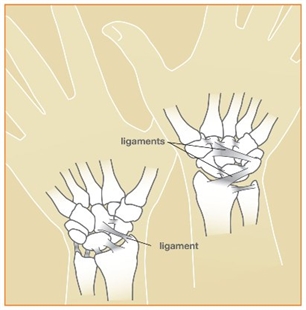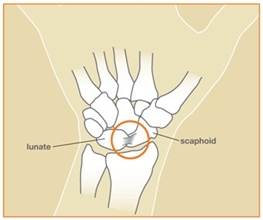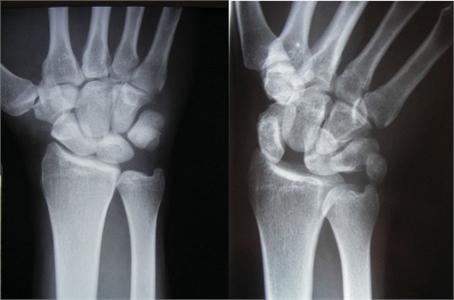Home | Education | Fractures and Sprain | Wrist Sprains

Figure 1: Ligaments of wrist

Figure 2: Diagram of the scapholunate ligament (circled)

Figure 3: X-ray showing a normal wrist (left) and an abnormal wrist (right) with a large gap between the scaphoid and lunate from ligament rupture
The information on this webpage is based on material from the American Society for Surgery of the Hand and is for educational purposes only.

Wrist Sprains
What are sprains?
A sprain is an injury to a ligament. Ligaments are the connective tissues that connect bones to bones; they could be thought of as tape that holds the bones together at a joint (see Figure 1).How do wrist sprains occur?
These types of injuries are common in falls and sports. The wrist is usually bent backwards when the hand hits the ground such as when someone slips or trips and falls. These injuries also frequently occur during sports such as football and snowboarding. After injury, the wrist will usually swell and may show bruising. It is usually very painful to move.Figure 1: Ligaments of wrist

What are the most common types of wrist sprains?
The most common ligament to be injured in the wrist is the scapho-lunate ligament (see Figure 2). It is the ligament between two of the small bones in the wrist, the scaphoid bone and the lunate bone. There are many other ligaments in the wrist, but they are less frequently injured. Sprains can have a wide range of severity; minor sprains may have minimal stretch of the ligaments, and more severe sprains may have complete ruptures of the ligament(s).Figure 2: Diagram of the scapholunate ligament (circled)

How are these injuries treated?
Initially your doctor will examine your wrist, to check its flexibility and stability and to see where it hurts. X-rays are taken to check the alignment of the wrist bones and to check for any fractures (see Figure 3). Occasionally other studies such as Magnetic Resonance Imaging (MRI) may be performed to help determine the diagnosis. Treatment may range from immobilization in a splint or cast to surgery. Surgery may consist of arthroscopic or open surgery. Arthroscopic surgery is performed through small (3-4 millimeter) holes in the skin where a camera and other special instruments are placed inside the wrist to confirm the diagnosis and potentially treat the ligament injury. Some injuries require open surgery in which an incision is made to repair and/or reconstruct the ligament. A variety of methods exist, which could include metal pins, screws, and other specialized devices. Patients are usually placed in a splint or cast after surgery which may need to remain on for 6-12 weeks after surgery. Your doctor will determine the best course of treatment.Figure 3: X-ray showing a normal wrist (left) and an abnormal wrist (right) with a large gap between the scaphoid and lunate from ligament rupture